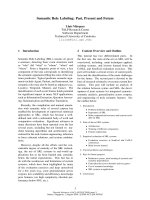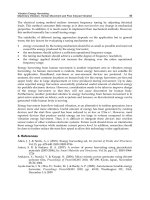The banking system of cyprus past, present and future
Bạn đang xem bản rút gọn của tài liệu. Xem và tải ngay bản đầy đủ của tài liệu tại đây (13.65 MB, 169 trang )
THE BANKING SYSTEM OF CYPRUS
Also by Kate Phylaktis
FINANCIAL DATA OF BANKS AND OTHER FINANCIAL INSTITUTIONS
INTERNATIONAL FINANCE AND THE LESS DEVELOPED COUNTRIES
(editor with M. Pradhan)
The Banking System
of Cyprus
Past, Present and Future
Kate Phylaktis
Reader in International Finance
Director of the Research Centre in Financial Development
City University Business School
London
palgrave
macmillan
© Kate Phylaktis 1995
Softcover reprint of the hardcover 1st edition 1995
All rights reserved. No reproduction, copy or transmission of
this publication may be made without written permission.
No paragraph of this publication may be reproduced, copied or
transmitted save with written permission or in accordance with
the provisions of the Copyright, Designs and Patents Act 1988,
or under the terms of any licence permitting limited copying
issued by the Copyright Licensing Agency, 90 Tottenham Court
Road, London WIP 9HE.
Any person who does any unauthorised act in relation to this
publication may be liable to criminal prosecution and civil
claims for damages.
This book is printed on paper suitable for recycling and made from fully
managed and sustained forest sources. Logging, pulping and manufacturing
processes are expected to conform to the environmental regulations ofthe
country of origin.
First published 1995 by
MACMILLAN PRESS LTD
Houndmills, Basingstoke, Hampshire RG21 2XS
and London
Companies and representatives
throughout the world
ISBN 978-1-349-12868-6 (eBook)
ISBN 978-1-349-12870-9
DOI 10.1007/978-1-349-12868-6
A catalogue record for this book is available
from the British Library.
\0
04
9 8
03 02
7
01
6
00
5
99
4
98
3
97
2
96
I
95
To my family
Contents
xi
Preface
PART I
THE PAST
1 The Origins of Modern Banking in Cyprus
1
The Establishment of the First Bank
2 The Development of Local Banking Institutions
3 A Comparison of Banking Strategies of Local and Foreign
Banks
4 The Stability of the Banking System
5 In the Aftermath of the Banking Crisis
6 The Decline of the Foreign Banks
5
5
8
10
15
16
18
2
The Financing of Agriculture
23
1
The Farmers and their Produce
23
24
2 The Financing Requirements of Farmers
3 Financing Agriculture at the End of the Nineteenth
4
5
6
7
Century and Early Twentieth century
The Development of the Co-operative Movement
The Establishment of the Agricultural Bank
The Establishment of the Central Co-operative Bank
Some Remarks on the Development of Co-operation
26
29
31
35
37
3
Banking without a Central Bank
42
1
The Monetary and Banking System
2 Performance of Central Banking Functions
3 Cyprus Banking, a Satellite of the English Banking System
PART II
42
44
45
THE PRESENT
4
The Central Bank of Cyprus
53
1
Reasons for Establishing the Central Bank of Cyprus
53
58
2 The Establishment of the Bank
vii
viii
3
4
5
6
7
Contents
The Relation Between the Central Bank and the Money Banks
Monetary Policy in the Early Years
Monetary Policy: 1974-80
Monetary Policy: 1981 to the Present
Central Bank Performance
59
62
65
67
71
5 The Banking System during Independence
76
1
2
76
76
77
83
3
4
6
Introduction
The Growth of the Commercial Banking Sector
2.1 Liabilities
2.2 Assets
2.3 Factors which contributed to the expansion of the
commercial banking sector
The Commercial Banks
3.1 The Bank of Cyprus
3.2 The Cyprus Popular Bank
3.3 The Hellenic Bank
3.4 Barclays Bank
3.5 The National Bank of Greece
3.6 The Arab Bank
3.7 Lombard Natwest Bank
3.8 Relative size and performance
3.9 Developments in banking structure
Other Financial Institutions
4.1 The Cyprus Development Bank
4.2 The Mortgage Bank of Cyprus
4.3 Housing Finance Corporation
84
85
85
87
88
88
88
89
89
89
93
95
99
102
102
Co-operative Societies: Growth and Crisis
105
1 Introduction
2 The Growth of the Co-operative Movement
3 The Central Co-operative Bank
3.1 Developments: 1963 to 1979
3.2 The legal structure governing the co-operative
movement
3.3 The crisis
4 Final remarks
105
105
III
III
112
114
117
Contents
PART ill
7
THE FUTURE
Cyprus: An Emerging Offshore Banking and Financial
Centre
1 Characteristics of Cyprus as an Offshore Banking and
2
3
4
8
125
128
129
130
132
The Existing Regulatory Framework of the Banking
System and Prospective Changes
134
accounts of banks and other financial institutions
Commission's recommendation on monitoring and
controlling large exposures of credit institutions
2.4 Directive on a solvency ratio for credit institutions
2.5 Directive on own funds
2.6 Directive concerning the reorganisation and the
winding-up of credit institutions and deposit-guarantee
schemes
Comparison of EC Directives with the Proposed Cyprus
Banking Bill
3.1 Limitations on credit facilities
3.2 Limitations on shareholding
3.3 Regulations on minimum capital
3.4 Regulations on capital adequacy
3.5 Liquidity requirements
3.6 Publications of accounts
3.7 Deposit guarantee schemes
Further Comments on the Proposed Cyprus Banking Bill
2.3
4
125
Financial Centre
A Comparison of the Experience of Cyprus and Bahrain
as Offshore Banking Centres
2.1 Developments in offshore banking activities in
Cyprus
2.2 Bahrain as an offshore banking centre
Prospects for Offshore Banking Business in Cyprus
Some Final Remarks
1 Existing Prudential Regulations and Legal Framework
2 The EC Banking Directives
2.1 The second Banking Co-ordinate Directive
2.2 Directive on the annual accounts and consolidated
3
ix
128
134
137
137
138
139
139
140
141
141
141
142
142
142
142
142
143
143
Contents
x
9
2
3
4
5
Banking in Cyprus in the 1990s
145
Main Characteristics of the Current Banking Industry
l.1 Private ownership
1.2 A substantial semi-informal sector
1.3 A highly concentrated commercial banking sector
1.4 A saturated banking sector
1.5 A profitable commercial banking sector
1.6 Substantial conduct regulation
Effects of Domestic Deregulation
Effects of Adopting the EC Banking Directives
Abolition of Foreign Exchange Controls
Final Remarks
145
145
146
146
147
147
147
148
151
153
153
Index
159
Preface
This book is intended to be a comprehensive study of the banking
system in Cyprus from the time that the first bank was founded on the
island in 1864. The aim is to present not only the history of banking
over this one hundred and thirty year period but a thorough analytical
discussion as well. In addition, I examine likely future developments in
the banking industry of Cyprus.
I hope that the book be of value to students, academics and
practitioners. Undergraduate and postgraduate students taking financial
development courses will find both the general analysis and that specific
to Cyprus on the development of financial structures of great interest. At
the same time, academics and banking practitioners who are interested
in the onshore and offshore banking activities on the island will find the
book informative on both past developments and the present situation.
The motivations for writing this book have been many. Through my
visits to the banks in Cyprus in the early 19808, I became aware of the
lack of a comprehensive study of the banking system on the island
despite the many Cypriot academics and scholars in Cyprus and the rest
of the world. At the same time, I was becoming interested in the
financial aspects of developing countries as a result of my research and
teaching responsibilities. It became clear to me that undertaking a study
of banking in Cyprus would give me the opportunity to examine the
development of the financial structure of a small economy and indeed of
an ex-British colony. Very few authoritative studies have been written
on these topics. Finally, the most important reason for this research was
a desire to offer something tangible, however small, to my native
country. Being a member of a University Department of Banking and
Finance gave me a comparative advantage over others in this field of
research.
I am greatly indebted to the Cyprus Popular Bank for the financial
and other support that it has given to me. Indeed the book could not
have been made possible without its kind assistance. The subject was
first raised with Mr Kikis N. Lazarides, the Chairman of the Bank, in
the mid-1980s. The initial proposal was to write a short book on the
historical development of the banking system in Cyprus. Through the
years, however, the book evolved into a comprehensive study not only
xi
XII
Preface
of the development of the banking system but also of its current state
and future prospects.
I would like to thank in particular the following members of the
Bank: Mr Panayiotis Mallis who was always ready to discuss
innumerable issues that emerged during the writing of the book; Alecos
Sergides, who although no longer with the Bank, provided me with
invaluable help in collecting and discussing the information used in the
book, especially the historical material; and Niki Papadopoulou and
Yiannis Tirkides for assisting me in the later stages of my research.
I am also grateful to many other people who helped me either by
providing information or in giving their comments on earlier drafts of
the manuscript. The book benefited enormously from the comments of
Christopher Clay (who also provided me with some important
documents from the surviving archives of the Imperial Ottoman Bank),
Forest Capie, Geoffrey Jones, Leslie Presnell and Geoffrey Wood. I am
also indebted to the Cyprus Public Records Office, the Bank of Cyprus,
the Cyprus Popular Bank and the Ionian Bank for permission to use
their archives. I am particularly grateful to the many people at the
Central Bank of Cyprus, the Bank of Cyprus, Barclays Bank, Lombard
Natwest and the Development Bank, who gave their time to answer my
queries and for sending me information. I also benefited from the
suggestions and comments of participants at the British Middle Eastern
Society Conferences, the Institute of Commonwealth Studies, and the
City University Business School workshops.
I would like to thank my secretary Kathleen Bergin, who undertook
the typing of the book. She carried out the task with great efficiency and
cheerfulness and produced an excellent typescript.
Finally, I want to thank my husband Akis, my daughter Alexandra and
my son George for their encouragement and for their support in helping
me complete this book. I thank them for being so patient during our
holidays in Cyprus when I spent so much time collecting information
and interviewing people. I will never forget the times Alexandra fell
asleep on library carpets while waiting for me to go through piles of old
newspapers in an effort to unravel the past. Holidays in Cyprus will
never be the same again: for most of the last eight years they have been
associated with writing this book.
KATE PHYLAKTIS
Part I
The Past
Introduction
In Part I of the book, we look at the historical development of the
banking system on the island from the establishment of the first formal
banking institution in 1864, to the setting up of the Central Bank of
Cyprus in 1963. We trace the origins of modern banking, which are
found, as in all developing economies and especially the colonies, in the
establishment of branches by foreign banks. Their banking business,
however, concentrated on financing trade and lending to safe customers,
such as expatriate firms and the colonial government, and left the
majority of Cypriots without access to banking facilities. As a result, at
the turn of the century, two types of local institutions were developing
simultaneously: the savings banks, the objective of which was to serve
the small saver and borrower, and the co-operative societies, which
aimed to solve the financing problems of the peasant farmers.
In Chapter 1, we study the development of the savings banks into
proper commercial banks and we contrast their banking strategies with
those of the overseas banks.
In Chapter 2, we concentrate on the co-operative societies. We
examine, first, the nature of the financing needs of farmers, who
constituted the majority of the population at the time, and the
unsuccessful private attempts to set up an agricultural bank. We
examine the development of the co-operative movement and analyse the
reasons for its success in the provision of financing facilities to farmers.
Co-operation has not been specific to Cyprus, but a world-wide
movement. The movement was established in Great Britain, when the
Rochdale Equitable Pioneers Society was founded in Lancashire in
1844 by 28 cotton-weavers, and it spread to Ireland, the Dominions,
India, and many other territories which were under British administration such as Palestine, Ceylon, Nigeria, etc. It also became an important
movement in practically all the countries of Europe and the United
States, China, Japan, and Egypt.
There was, however, a main difference between the development of
the commercial banking sector and that of the co-operative societies
during the first half of the twentieth century. The former developed
without the backing of a central bank, while the latter formed its own
Central Co-operative Bank in 1938.
3
4
The Past
In Chapter 3, we deal with the issue of how the central banking
functions were performed for the commercial banks prior to the
establishment of the Central Bank of Cyprus in 1963. We also discuss
how the banking system in Cyprus was not in fact 'free', but operated as
a satellite of the British banking system.
1 The Origins of Modem
Banking in Cyprus
'There is not a single bank in all the island, and as capitalists are rare
in Cyprus, the want of an establishment of the kind is sensibly felt,
especially within the last few years, in which commerce, both in
imports and exports, has been so much developed. At present, merchants find themselves compelled to negotiate at Beyrout their
draughts on Europe, which causes them delay, expence and risk while
it fetters the course of these transactions.' (Commercial Report 18548, Accounts and Papers, vol. 16, 1859, p. 50l)
THE ESTABLISHMENT OF THE FIRST BANK
The first bank to establish a branch on the island was the Imperial
Ottoman Bank. This Turkish-registered bank had been created in 1863,
and was virtually an Anglo-French creation with management control
resting in twin committees in London and Paris. By the 1880s, however,
the bulk of the equity was in French hands. 1 The Imperial Ottoman Bank
opened a branch in Larnaca in May 1864,2 probably because it was
anxious to receive a share of the Cyprus trade in cotton, an attractive
proposition during the cotton famine of the early 1860s.3
The Imperial Ottoman Bank soon expanded to other parts of the
island. In the nineteenth century Cyprus was overwhelmingly an
agricultural economy. Exports of agricultural produce. such as carobs,
wine, wheat and barley, contributed 70 per cent of total exports in the
late 1880s. 4 It was not until the 1900s that a mining sector developed,
and this only gained real significance from the late 1920s and,
especially, after 1945 when world prices of metals and pyrites soared.
The Imperial Ottoman Bank developed a business in the financing of
agricultural trade through bills of exchange, opening in Limassol, for
example, to take part in the financing of the wine and carob trade. s The
Bank's other main activity was its role as official banker to the British
colonial government; it maintained a branch in Nicosia to facilitate the
handling of this business. Cyprus came under British rule in 1878,
5
6
The Past
having been occupied through the Anglo-Turkish Convention of
Defensive Alliance. 6 It became a fonnal Crown Colony in 1923.
The Imperial Ottoman Bank's monopoly was interrupted in 1879
when the Anglo-Egyptian Bank, a British-registered overseas bank with
a branch network in Egypt, opened a branch in Larnaca and
subsequently a branch in Nicosia and agencies in Limassol, Paphos and
Kyrenia. 7 The establishment of the bank in Cyprus was prompted by the
gradual growth of trade between the island and Egypt. However, in
1890 the Anglo-Egyptian Bank's operations in Cyprus were taken over
by the Imperial Ottoman Bank.s The reason for the Anglo-Egyptian
Bank's withdrawal is not clear, but it seems from the Imperial Ottoman
Bank's perfonnance that banking business in Cyprus during those early
years was not very profitable. Reports sent from the Larnaca branch to
the head office in London between the 1860s and the 1880s indicate that
the bank's operations in Cyprus generated only small profits. The profits
derived mostly from discounts, interest payments on advances and
exchange operations.9 The Imperial Ottoman Bank's government business was also profitable. During the 1890s government balances with
the Bank constituted 30-50 per cent of the Bank's deposits. lO
Government business also lent the Bank considerable prestige.
Yet the Imperial Ottoman Bank itself met with some difficulties
during the late 1890s. In August 1897, it was decided that the three
branches in Larnaca, Limassol and Nicosia were to be liquidated over a
period of two to three years because of losses. ll In August 1898, the
Limassol branch was duly closed down, and the branch in Nicosia
relegated to the position of an agency dependent on Larnaca. 12 This
provoked an outcry in Cyprus, especially among the merchants, who
called (unsuccessfully) for the government to intervene and give a
subsidy to the Imperial Ottoman Bank. 13 In fact, in 1900 the Bank
reopened the establishment in Limassol on the same basis as that of its
Nicosia operation. The reason for reopening was the fear that the Bank's
Limassol correspondent was about to set up his own bank with links to
Beirut, Alexandria and Europe. based on the business the Imperial
Ottoman Bank had abandoned by closing down. 14 This climate of
uncertainty about the provision of banking facilities on the island was,
perhaps, the main stimulus behind the establishment of the first fonnal
local banking institution, in January 1899. A more long-tenn factor,
however, was the large gap in the market caused by the Imperial
Ottoman Bank's business strategy.
The Origins of Modern Banking in Cyprus
7
The Bank, like British overseas banks elsewhere, was mainly
interested in the financing of trade, so when it set up branches in Cyprus
they were in Limassol and Larnaca, the main ports of the island. IS The
banks were not interested in financing the Cypriot peasant farmers who,
however, were in constant need of funds. The crops were subject to
weather conditions and Cyprus suffered regularly from droughts.
Furthermore, the com was ground by water-mills, so that in a time of
drought there was not only a scarcity of water, but also of bread. The
peasants were additionally burdened with tithes on all agricultural
produce.I6 The tithes rested on the theory that all land belonged to the
Crown which granted tithes to segments of it in return for 10 per cent of
the yearly produce. But most important of all, the prosperity of the
farmers depended on the price that could be obtained for cereal produce.
During the 1870s and 1880s there was a slump due to the cheap grain
Europe was importing from India and America. The profits of cereal
farming fell by more than 50 per cent in this period. I7
The Imperial Ottoman Bank's lack of interest in providing credit
facilities to the peasants was based on three grounds. IS First, there was
no cadastral survey, which meant that the Bank could not safely assume
that a peasant who occupied a piece of land was really the proprietor
registered in the Cadastral Department. This weakened considerably the
security which would be offered by the land. For that security to be
reliable, it would have been necessary to ascertain beforehand, by
detailed investigations, the properly rights of applicants for loans, a
formality which would have involved the employment of a great
number of experienced and trustworthy clerks.
A second reason for not lending to the peasants was related to the
high probability that the money lent would pass into the hands of the
existing creditors of the peasants, the traditional moneylenders. It was
acknowledged, however, that the liberation of the peasants from the
hands of the userers would improve the peasants' condition; but such a
relief would be only temporary, because of the frequency of droughts
and the resulting instability of crop yields. Furthermore, the peasants
were rarely in a position to offer sufficient security to obtain sufficient
credit from the banks to repay their debts to their existing creditors.
The,·.·ird but most important reason for abstaining from lending to
the peasants was related to the realisation of the security when the
peasant was unable to repay the loan to the bank. In that case, the bank
would be faced with two alternatives: either to render the advance
8
The Past
perpetual and thus to make an immovable investment, or to sell the
acquired land. SeIling was anticipated to be difficult, especially when
the seller was a bank. The Imperial Ottoman Bank - like other British
overseas banks - sought to maintain its advances in as liquid a fonn as
possible, and, as a principle, to abstain from making advances on real
property, except in cases where it was obliged to consolidate by
mortgage. The Bank was, however, prepared to lend directly to the
British government in Cyprus, at a moderate rate of interest (say, 5 per
cent), for the purpose of on-lending to the peasants.
2
THE DEVELOPMENT OF LOCAL BANKING INSTITUTIONS
It was against this background that, in January 1899, the first modern
local banking institution, the Nicosia Savings Bank, was established,
headed by a prominent local lawyer, John Economides, who was also a
member of the Legislative CounciJ.19 This institution, which was based
on the Italian Popular Banks, aimed to mobilise the savings of the small
depositor. The capital of the bank was to be accumulated by small
weekly deposits. The prospective shareholder deposited one shilling
weekly in a special account for a period of five years for every share he
wanted to buy and received a maximum of 5 per cent interest p.a. on the
deposits. At the same time, shareholders could borrow up to 75 per cent
of the amount of their shares without further guarantee other than the
shares themselves, at 8 per cent annual interest rate. Although shareholders were given priority in loans, non-depositors could also borrow
from the bank, at the higher interest rate of 9-12 per cent. These loans
were always backed by guarantee or mortgage, the value of which was
decided by the Executive Committee.
The nominal capital of the bank was £60,000, divided into 6,000
£ 10 shares. In order to attract and protect the public, the voting power
in general meetings was related to the number of shares held. A holder
of one share had one vote, of three shares two votes, of five shares
three votes, of eight shares four votes and of 10 shares and over five
votes.
The Nicosia Savings Bank was well managed. General meetings, at
which the board was selected and the dividends decided, were
announced in the press. The books were kept in order and balance statements were published twice a year. Initially, the management was
The Origins of Modem Banking in Cyprus
9
undertaken by the establishing members, who were all distinguished
persons of the community, on a voluntary basis.
The depositors and shareholders of the savings bank originated from
the middle and lower urban social classes, mostly housewives, shopkeepers, clerks, factory workers and servants. (The upper classes
preferred to use the services of the foreign banks.)
The shares of this savings bank are £10 each, with an entrance fee of
5s added. Of the 2,000 shareholders in all, by the way, 766, holding
among them 1,271 shares, are women, nine-tenths of whom are bona
fide working women, that is, weavers and servants.20
The savings bank was left entirely free by law to do whatever it
pleased with its funds. In general, the bulk of credits was channelled to
(small-size) businesses, craftsmen and shopkeepers. The basic criterion
for the granting of a loan was the quality of personal guarantees.
Following the example of the Nicosia Savings Bank, other savings
banks were established in Nicosia and in other towns of the island: the
Popular Savings Bank of Limassol and the Moslem Savings Bank of
Nicosia in 1901; the Cyprus Savings Bank in Nicosia in 1903; and the
Omonia Savings Bank in Lamaca in 1905. In addition, the colonial
government set up its own savings bank in each of the six principal
towns in 1903. This decision was probably in response to the private
sector's initiative, for the law allowing the government to set up savings
banks was passed soon after the establishment of the Nicosia Savings
Bank. 21 The Government Savings Bank was based on different rules. Its
aim was to collect deposits from small savers by offering them interest
of 2.5 per cent per annum. The Bank did not lend to the private sector
but rather invested its funds in the London money market. These rules
did not present strong competition to the private savings banks, which
not only offered more attractive rates but also lent to the local community. As a consequence, the number of depositors, the great majority of
whom were government officials, never exceeded 330 and their deposits
hardly reached £18,000 during the 26 years' lifespan of government
savings banks. In 1929, a year for which we have figures for both Government and private savings banks, the former had deposits of £841
compared with £122,000 for the latter.22
A key factor in the growth of the Nicosia Savings Bank was the change
of its status in 1912. As the savings bank was growing, and lending to
10
The Past
persons other than shareholders rose, the initial constitution with unlimited
liability became less suitable. The British government in Cyprus and in
London was reluctant to enact appropriate legislation, but it gave pennission to the Executive Board of the Bank to change the Bank's status into a
Societe Anonyme, on the basis of the Ottoman Commercial Law which
existed in Cyprus and which was in tum based on the Napoleonic code. The
name of the institution was also changed to Bank of CypruS.23 In this way,
the bank enjoyed limited liability prior to the 1922 Company Law which
established limited liability on the island. The new legal status encouraged
further expansion. During the period 1910-20 the capital of the Bank of
Cyprus was increased, and £4 as well as £ 10 shares were offered through
the practice of weekly deposits. In 1919, another branch was opened in
Limassol. 24 By 1920 the capital of the Bank had reached £157,424.
During the interwar years there was an increase in the number of both
local and foreign banks in Cyprus. The number of domestic banks
increased following the 1922 Company Law. Two savings banks, the
Popular Bank of Limassol and the Larnaca Bank, changed their status
and attained limited liability while three new banks were established the
Popular Bank of Paphos, the Melissa Bank, and the Famagusta Bank. In
addition to the above local banks, an Agricultural Bank was established
in 1925, following the Agricultural Bank Law enacted in the same year
which initiated a new era in the financing of fanning as well as in the
trade of agricultural goods. The Bank was set up under the joint
auspices of the government and of the Ottoman Bank. 25
Over the same period, three foreign banks established offices in
Cyprus. In 1910 the Bank of Athens opened a branch in Limassol, and
later on agencies in other main towns. 26 In 1926 the Ionian Bank, a
British overseas bank with a branch network in Greece and Egypt and
its Head Office in London, established a branch in Nicosia and agencies
in Famagusta, Lamaca and Limassol. 27 In 1937 the largest British
overseas bank of the period, Barc1ays Bank (Dominion, Colonial and
Overseas), established a branch in Cyprus. 2B
3
A COMPARISON OF BANKING STRATEGIES OF LOCAL AND
FOREIGN BANKS
The establishment of local financial institutions was soon followed by a
loss of market share by the foreign banks. Tables 1.1 and 1.2 present the
The Origins of Modern Banking in Cyprus
Table l.l
Year
Market share of commercial banks in Cyprus, 1878-1959
(percentage of total deposits)
Popular
Bank of
Limassol
1878
1890
18911910
1911
1915
1920
1925
3.9
1930
1935 11.5
1938
9.9
7.7
1946
5.9
1950
3.0
1955
1959
3.6
II
Bank
of
Cyprus
Ottoman
Bank
Bank
of
Athens
Ionian
Bank
Barclays Others
(DCO)
100.0
67.0
42.4
18.8
13.4
13.1
17.5
21.9
28.7
38.8
33.9
54.1
100.0
45.3
44.9
62.1
52.9
27.0
37.4
29.3
29.2
na
na
na
33.0
54.7
12.7
19.1
33.7
25.5
12.1
9.7
7.8
na
na
na
22.8
15.3
17.8
10.8
na
na
na
4.7
13.2
na
na
na
7.7
6.2
6.7
2.6
na
na
na
Source: The Cyprus Blue Book - various issues; and Balance Sheets of the Bank
of Cyprus and the Popular Bank of Limassol ( now the Cyprus Popular Bank).
available data on bank deposits in Cyprus. In 1915 the Bank of Cyprus
held 42 per cent of the commercial banks' market after it obtained
limited liability status (Table 1.1). This substantial market share reflects
the relative importance of the institution as a savings bank in the early
part of the twentieth century. It seems, however, that the Bank of Cyprus
could not initially compete with the foreign banks which soon
commanded 81 per cent of bank deposits in Cyprus (Table 1.2). Their
market share increased further in the first half of the 1920s - primarily
because of the success of the Greek-owned Bank of Athens in attracting
funds - but thereafter declined steadily. By 1938 the foreign banks held
62 per cent of the market, a level maintained for the next 15 years or so,
until a dramatic fall in the years before independence reduced their
market share to about 42 per cent. 29 Of the individual institutions, the
great gainer was the Bank of Cyprus, whose market share of deposits
12
The Past
Table 1.2
End
of
1888
1890
1895
1900
1910
1915
1920
1925
1930
1935
1938
1946
1950
1955
1959
Deposits of commercial banks in Cyprus, 1888-1959
(£s)
Deposits
of local
banks
Deposits
offoreign
banks
(I)
(2)
58,200
83,900
78,500
267,286
422,270
780,899
3,838,772
4,205,800(a)
8,893,9(00 )
21,705,900(0)
27,992
45,539
36,000
41,000
78,200
79,061
362,466
507,870
825,327
783,914
1,257,830
6,001,414
5,266,523(a)
15,206, 1oo(a)
15,294,100(0)
Total
deposits
Change
in deposits
over
previous
period
(3)
Ratio of
deposits
offoreign
banks to
total
deposits
(per cent)
(2)1(3)
na
63
-21
14
91
76
225
31
84
12
69
383
I
I
I
1
I
0.58
0.81
0.87
0.76
0.65
0.62
0.61
0.56
0.63
0041
27,992
45,539
36,000
41,000
78,200
137,261
446,366
586,370
1,092,613
1,206,184
2,038,729
9,840,186
9,472,223
24,100,000
37,000,000
-4
254
156
(a) These are estimates since the figures for the Co-operative Central Bank, the
Turkish Bank and the Turkeye Ish Bank have been included under column (2).
Source: The Cyprus Blue Book - various issues; and balance sheets of some of
the local banks.
grew from 13 per cent in 1925 to 54 per cent in 1959 (Table 1.1). The
great losers were the Ottoman Bank, whose 62 per cent share of deposits
in 1920 had fallen by half by 1946, the Ionian Bank, which had captured
nearly a quarter of deposits in 1930 only to have its share reduced to 10
per cent 16 years later, and the Bank of Athens, which had made a
dramatic entry in 1911, but where business fell away during the 1930s
and the Second World War.
What were the advantages of the Bank of Cyprus which enabled it to
challenge its larger, and in the case of the Ottoman Bank longerestablished, foreign rivals? Part of the answer lay in the different
organisational structure of the local banks compared with the foreign
The Origins of Modem Banking in Cyprus
13
banks. The local commercial banks evolved from the savings bank the
capital of which was to be accumulated from small weekly savings, and
their loans were allocated mainly to the shareholders guaranteed by the
shares themselves. This organisational structure had implications for the
credit policies adopted. The customer base of the local banks, especially
the Bank of Cyprus, was very wide. The substantial involvement of the
banks with the local community provided them with excellent customer
information which enabled them to be flexible in their credit policies.
This contrasted strongly with the rigid credit policies of the foreign
banking institutions. The local managements of the foreign banks were
given precise instructions about the terms and conditions attached to
various types of assets as well as limits on each type of asset they could
hold. 3C Flexibility was not permitted even when the local management
of a foreign bank requested it. 31
Cyprus, of course, formed only a small part of the activities of the
international banks. Evidence from the Ionian Bank's operations
indicated that there was a direct link between the Bank Rate in England
and the lending and deposit rates offered by the foreign banks in
CypruS.32 This is not surprising since surplus funds of the foreign banks
in Cyprus were invested in the London markets. In the case of the Ionian
Bank, these surplus funds often amounted to more than 50 per cent of
total deposits. 33 In effect, the foreign banks were exporting capital at a
time when the local market was struggling for capital funds. In contrast,
the local banks did not invest in foreign securities. The implication of
the foreign banks' policy was that interest rates offered by them in
Cyprus did not bear any relationship to the needs or circumstances of
Cyprus. In fact, the local banks offered, on the whole, higher deposit
rates.
There were also differences in the business policies of the local and
foreign banks. The foreign banks were mainly interested in large
customers, both because of the economies of scale in collecting
infonnation and the reduced risk attached to such lending. The big
customers on the island were the government and the few expatriate
firms in the mining industry. There was a lot of aggressive competition
between the foreign banks to obtain these accounts. For example, the
Ionian Bank tried - albeit unsuccessfully - in the late 1920s to win the
accounts of the Cyprus Asbestos Company, which banked with the Bank
of Athens, and the Cyprus Mining Corporation, which banked with the
Ottoman Bank. 34
14
The Past
The Ionian Bank also competed aggressively to obtain the accounts
of the government which the Ottoman Bank had held since the beginning of British rule. In 1927, the Ionian Bank offered 1~ per cent
below the Bank of England Rate, with a maximum interest of 4! per
cent, on total government balances exceeding £5,000. This was more
advantageous for the government than the 2 per cent on government
balances and 118 per cent commission on turnover paid by the
Ottoman Bank since 1905 - the Bank of England Rate during that
period averaged more than 4 per cent. The government retained its
accounts with the Ottoman Bank, but did use the Ionian Bank's application as a lever for obtaining better terms. 35 The government
accounts continued to provide the Ottoman Bank with considerable
advantages, making the success of the Bank of Cyprus more striking.
The Ottoman Bank collected cash on behalf of the government and
transferred it to a centre where it could earn interest. When the government was drawing cash and the Ottoman Bank did not have large
amounts of cash in hand (because it had been invested in London to
earn interest) it sold drafts to the public at the cheapest rate. These
operations therefore affected the business of buying and selling drafts
and cheques by other banks. 36
Apart from the big expatriate firms and the government, the foreign
banks and, in particular, Barclays Bank (DCO) supported the Central
Co-operative Bank which was established in 1938.37 This was a radical
new departure for British overseas banks, and demonstrates that their
credit policies were by no means as universally conservative as has been
imagined. Barc1ays entered the Cyprus market through this mechanism,
thus carving a distinct niche for itself, while leaving government
business in the hands of the Ottoman Bank and most trade finance with
the Ionian Bank. The establishment of the Central Co-operative Bank
gave a boost to the co-operative movement by accepting surpluses of
funds from deposits of various co-operative societies and lending to
other societies in need of funds. Barclays provided an initially important
source of funds to the Central Co-operative Bank.38 The funds were
advanced as an overdraft, on the security of British government bonds
and promissory notes of member societies. In 1938 Barclays provided
45 per cent of the Central Bank's working capital, though by 1941 that
figure had fallen to 37 per cent.39 The co-operative movement, with the
help of Barclays Bank (DCO), finally tackled the problem of rural debt,
an issue discussed in Chapter 2.









